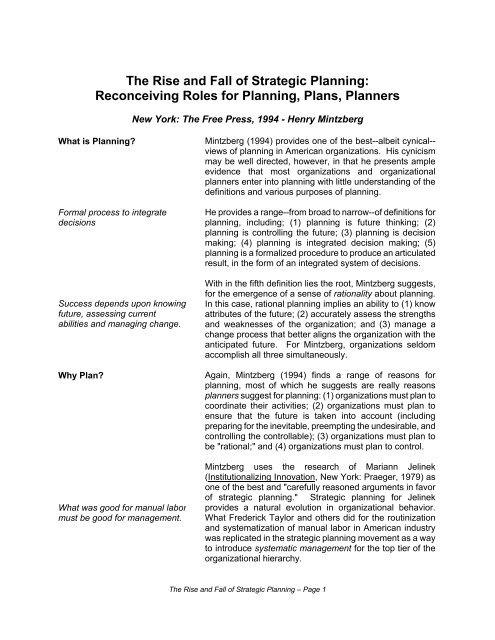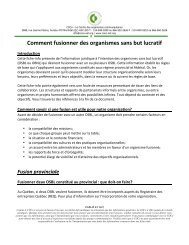Rise and Fall of Strategic Planning â PDF - COCo
Rise and Fall of Strategic Planning â PDF - COCo
Rise and Fall of Strategic Planning â PDF - COCo
You also want an ePaper? Increase the reach of your titles
YUMPU automatically turns print PDFs into web optimized ePapers that Google loves.
would be "undermined by the pursuit <strong>of</strong> self-interestthrough confrontation <strong>and</strong> conflict" (p. 188). He findsplanning neither apolitical nor objective.The design <strong>of</strong> the planningprocess predicts the outcomeProblems in suppressing politicsduring planningThe need for control createsleaders who see only turbulencearound them.Four sins <strong>of</strong> trivial planning.Leaders or managers <strong>of</strong> planning activities can shape thefinal outcome <strong>of</strong> the process by the design <strong>and</strong>implementation <strong>of</strong> the planning process. Their bias may beexpressed as "planning as an end unto itself,""consideration <strong>of</strong> a narrow form <strong>of</strong> rationality," "towardsteady incremental change rather than periodic quantumchange," "toward centralized power...<strong>and</strong> away from theneeds <strong>of</strong> influences whose stake in the organization is notformally economic," "toward short-run economic goals," <strong>and</strong>"toward simpler, impoverished forms <strong>of</strong> strategiesthemselves" (p. 196).When planning avoids the politics <strong>of</strong> the organizations,leaders tend to find themselves managing sharpenedconflicts when the plans face implementation. Bysuppressing natural conflicts, self-interest, goal trade-<strong>of</strong>fs,resource redistribution <strong>and</strong> the political dimensions <strong>of</strong> anorganization in the planning process, the final plan lacksrealism <strong>and</strong> practicality.<strong>Planning</strong> <strong>and</strong> Control. <strong>Planning</strong>, according to Mintzberg(1994) seems to appeal to the leader's interest in control<strong>and</strong>, concurrently, an aversion to risk, avoidance <strong>of</strong>creativity <strong>and</strong> truly "quantum changes." The link betweenplanning <strong>and</strong> control than leads to the pitfall repeatedthroughout history <strong>of</strong> planners who characterize their periodas the most turbulent (<strong>and</strong> therefore heightening the needfor control through planning). Like Chicken Little, thosewith a higher need to plan <strong>and</strong> control may experience evensubtle changes as "environmental turbulence."What he describes as a second pitfall--the illusion <strong>of</strong> controlcreated through planning--then leads to a real purpose forcontinuous planning: public relations. That attitude byleaders results in the four sins <strong>of</strong> "trivial planning": (1) usepast trends to predict the future; (2) well-publicized <strong>and</strong>very public evidence <strong>of</strong> planning; (3) continuous planningwith insufficient time to effect change, <strong>and</strong> (4) pretending tochange in order to remain conservative (pp. 217-218).Fundamental <strong>Fall</strong>aciesMintzberg (1994) uses Chapter Five as a review <strong>of</strong> thefallacies <strong>of</strong> strategic planning. He ties the concept <strong>of</strong>fallacies to his last chapter through this borrowed definition:"An expert has been defined as someone who knowsenough about a subject to avoid all the many pitfalls on hisThe <strong>Rise</strong> <strong>and</strong> <strong>Fall</strong> <strong>of</strong> <strong>Strategic</strong> <strong>Planning</strong> – Page 4
or her way to the gr<strong>and</strong> fallacy" (p. 221). In Mintzberg's"gr<strong>and</strong> fallacy," the failures <strong>of</strong> planning are not coincidentalbut integral to the very nature <strong>of</strong> planning.Three assumptions underlyingstrategic planning.<strong>Fall</strong>acy <strong>of</strong> PredeterminationThe three assumptions underlying strategic planning are: (1)assumptions <strong>of</strong> formalization in which the strategy makingprocess can be programmed by the use <strong>of</strong> systems; (2)assumptions <strong>of</strong> detachment in which "thought must bedetached from action, strategy from operations, ostensiblethinkers from real does, <strong>and</strong>, therefore, 'strategists' from theobjects <strong>of</strong> their strategies;" (3) assumptions <strong>of</strong> quantificationin which "the strategy making process is driven by 'harddata,' comprising quantitative aggregates <strong>of</strong> the detailed'facts' about the organization <strong>and</strong> its environment.The act <strong>of</strong> planning assumes predetermination in theprediction <strong>of</strong> the environment; the unfolding <strong>of</strong> the strategyformation process on schedule; <strong>and</strong> the ability to impose theresulting strategies on an accepting environment. Inassuming the ability <strong>of</strong> planning to predetermine the future,the planner <strong>and</strong> the leader create the conditions by whichplans fail to meet expectations.A basic tenant <strong>of</strong> planning rests on forecasting, but theperformance <strong>of</strong> forecasting has been less than ideal.Forecasting fails to accurately predict discontinuitiesbecause it relies on extrapolations. More helpful has beenthe use <strong>of</strong> scenarios, especially when the scenarios arelinked to contingency planning.<strong>Fall</strong>acy <strong>of</strong> DetachmentQuantitative data drives outqualitative data (<strong>and</strong> informationon emerging trends).<strong>Fall</strong>acy <strong>of</strong> FormalizationMuch has been written on the need for strategy development<strong>and</strong> planning to be done away from routine <strong>and</strong> distinct fromdaily decisions. Unfortunately, this concept challenges boththe leader's ability to allocate time purely to planning <strong>and</strong> theleader's ability to be abstract while immersed in the dailyworld.The reliance on hard, objective data drives out qualitativedata which has a greater chance <strong>of</strong> reshaping theorganization <strong>and</strong> sensing subtle environmental changes. Inthe long run, Mintzberg points to the need for planners tomake conscious <strong>and</strong> articulated "attachments" to theirpersonal influences on the planning process.In the unknowing acceptance <strong>of</strong> this fallacy, Mintzberg(1994) suggests he is converging on the essence <strong>of</strong> thegr<strong>and</strong> fallacy. Strategy formulation, for Mintzberg, can notbe formalized nor innovation be institutionalized.The <strong>Rise</strong> <strong>and</strong> <strong>Fall</strong> <strong>of</strong> <strong>Strategic</strong> <strong>Planning</strong> – Page 5
Formal planning systems thatfailed or no formal systems atall?His discussion examines two dimensions <strong>of</strong> the fallacy <strong>of</strong>formulation: the possibility that formal systems <strong>of</strong> planningcreate dynamics which reduce the possibility <strong>of</strong> truly beingstrategic or the possibility that planning processes havenever really been formal (other than to follow a checklist).Two kinds <strong>of</strong> thinking lead todifferent kinds <strong>of</strong> strategy.Managers more simultaneous,holistic <strong>and</strong> relational.The Gr<strong>and</strong> <strong>Fall</strong>acyHis remaining discussion <strong>of</strong>fers a glimpse into Mintzberg'stheories for better planning. His ideas include the belief thatdifferent thinking styles <strong>and</strong> personal preference for decisionmaking make some people more adept <strong>and</strong> interested inplanning as an analytic process, while others prefer a morecreative <strong>and</strong> intuitive process. His challenge to leaders isthat they work to underst<strong>and</strong> the two different kinds <strong>of</strong>thinking processes.Mintzberg (1994) <strong>of</strong>fers research that finds managerial workappears to be more "simultaneous, holistic, <strong>and</strong> relationalthan linear, sequential <strong>and</strong> orderly" (p. 319). This wouldseem to suggest that managers would be more likely to finda "disorderly" <strong>and</strong> creative planning process more familiar<strong>and</strong> related to the real world <strong>of</strong> the organization.That leads him to a summative restatement <strong>of</strong> the gr<strong>and</strong>fallacy <strong>of</strong> the "planning school": "because analysis is notsynthesis, strategic planning is not strategy formation" (p.321). In short, "analysis can not substitute for synthesis. Noamount <strong>of</strong> elaboration will ever enable formal procedures t<strong>of</strong>orecast discontinuities, to inform managers who aredetached from their operations, to create novel strategies.Ultimately, the term 'strategic planning' has proved to be anoxymoron" (p. 321).The <strong>Rise</strong> <strong>and</strong> <strong>Fall</strong> <strong>of</strong> <strong>Strategic</strong> <strong>Planning</strong> – Page 6











